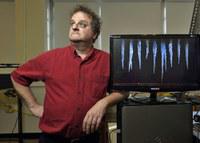And he has tried – and is still trying – to puzzle out the underlying theory that rules their cold and pointy essence.
And now he’s giving all of it away.
He calls it the Icicle Atlas . It’s an online database that includes nearly all of his icicle research to date, and it’s free for anyone to use without restriction, be they scientists, artists or Christmas-card designers.
It’s an uncommonly large amount of scientific data to make public – the equivalent of more than 200 DVDs worth – all dedicated to icicles. There’s never been anything like it. And in an era when physicists typically win Nobel prizes for studying unseen particles and phenomena that lie far beyond the reach of human senses, it’s just a little bit rebellious.
“I’m interested in patterns in nature in general,” says Prof. Morris, whose area of expertise is officially called experimental nonlinear physics, but which might just as easily be described as the science of everyday experience.
“I’m highly motivated to understand things that I see in front of me … things which are apparent to everyone but are relatively unexplained.”
And when Prof. Morris walks around the campus and the streets of the Toronto neighbourhood where he lives, icicles are what he sees in front of him.
Source of Article: http://www.theglobeandmail.com/technology/science/the-mysterious-and-cool-science-of-ice/article23241318/
Watch the mesmerizing process of building an Icicle Atlas
from the Globe and Mail
:
Toronto Star Article:
http://www.thestar.com/news/gta/2015/03/05/u-of-t-professor-creates-icicle-atlas-with-230000-icy-images.html
13 random rotating icicles from the Icicle Atlas on you tube:
https://www.youtube.com/watch?v=OXW-YmthUbQ&list=UUjqjgYc1Lmmw8GbajPDKgDg
"Why Icicles Look the Way they Do" in the New York Times:
http://www.nytimes.com/2015/03/17/science/why-icicles-look-the-way-they-do.html?ref=science&_r=1

